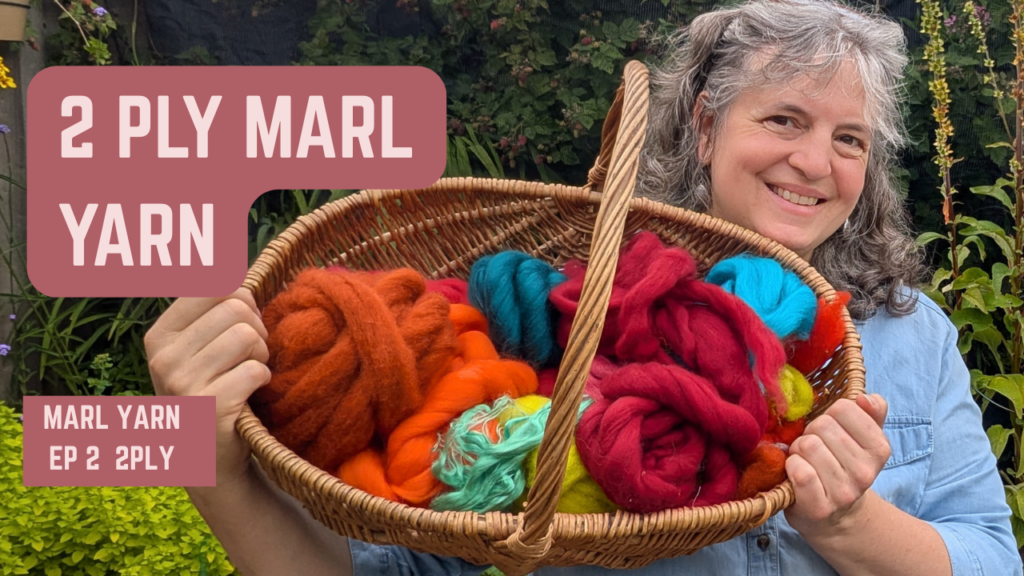Exploring 2-Ply Marl Yarns: A Handspinner’s Guide to Colourful Creativity
Whether you’re a knitter, weaver, or crocheter, the fabric you create begins with one key ingredient: yarn. For handspinners, yarn starts even earlier with fibre. How we combine fibres, their textures, colours, and types, dramatically influences the final look and feel of our yarn and the fabric it becomes.
In this blog post summarise my YouTube video about 2-ply marl yarns, and I’ll explore one of the most visually exciting and beginner-friendly yarn constructions: the 2-ply marl yarn. You’ll learn what it is, why it’s fantastic for hand spinning, how to play with colours, and what kinds of projects this yarn is perfect for.

What Is a Marl Yarn and Why Is It Great for Handspinning?
A 2-ply Marl yarn is created when two singles of different colours are spun and plied together. The result is a distinctive “barber pole” look, where the individual colours twist around one another, creating a beautifully variegated yarn. This effect is especially striking in 2-ply marl yarns, which provide bold contrasts and clear colour interactions.
Why is marl yarn ideal for handspinners?
- Beginner-friendly: It’s a forgiving and fun way to experiment with colour without advanced techniques.
- Colour play: Great for testing colour combinations, from complementary brights to soft neutrals.
- Texture and depth: Even with basic spinning, the visual texture of a marl yarn can make simple stitches pop.
- Instant gratification: You can see results as soon as you ply, making it a rewarding process.
Examples of 2-Ply Marl Yarns (and Fresh Colour Ideas)
Let’s take a look at a few classic and creative combinations you can try:
Traditional Contrast
- Black + White: This classic combo from Welsh Mountain sheep creates an oatmeal, marbled look. Great for rugged outerwear or woven rugs.
Tints,Tones & Shades of one Colour
- Cream + Chestnut Brown: Warm, soft contrast perfect for sweaters or accessories with a natural look.
Different Fibre Textures
- Grey Gotland + Soft Castle Milk Moorit: One spun worsted, the other long-drawn, not just a colour play, but also a texture experiment.
A Fresh Take: Bold and Bright
Let’s go bold! Try creating a 2-ply marl yarn using:
- Turquoise + Tangerine
- Dusty Pink + Sage Green
- Lavender + Mustard Yellow
These combinations offer high visual interest, and when you use tints, tones, or shades of complementary colors, you can tone down the intensity or lean into a vibrant, graphic look.
FAQ: All About 2-Ply Marl Yarns
Q: Is marl yarn the same as heathered yarn?
A: No. Heathered yarn is made by blending colours before spinning, giving a subtle, tweedy effect. Marl yarn is made by plying two differently colored singles, resulting in a more graphic, twisted appearance.
Q: Can I use different fibres in each single?
A: Absolutely! Just be mindful of how each fibre behaves; differences in elasticity, softness, and sheen can affect the final fabric.
Q: Will a 2-ply marl yarn always look variegated?
A: Mostly yes, especially with strong colour contrast. However, using colours close on the colour wheel (analogous colours) can yield a more blended, understated look.
Q: What if I don’t like the result?
A: Sample first! Keep swatches as a reference — they’re incredibly helpful when planning future projects.
Best Projects for 2-Ply Marl Yarns
2-ply marl yarns are wonderfully versatile. Here’s where they shine:
- Hats and Cowls: Small accessories let the colour play take centre stage.
- Textured Shawls: Marl yarns enhance stitch definition and add depth.
- Socks and Mittens: Use stronger fibres and smaller needles for durability and warmth.
- Woven Rugs or Wall Hangings: Heavier marl yarns offer bold patterns in simple weaves.
Because the visual patterning is baked into the yarn, even plain stitches and simple patterns look elevated and unique.
Conclusion: Spin, Ply, Play!
2-ply marl yarns are a gateway to creative colour exploration in hand spinning. Whether you’re a beginner looking to experiment or a seasoned spinner exploring texture and tone, marling opens the door to endless possibilities.
So, go ahead grab some fibre, spin two singles in wildly different hues, and let the yarn surprise you. The only rule? Sample, sample, sample. You’ll thank yourself later.
Join the Community!
Love fibre arts? Want spinning tips, natural dye recipes, project inspiration, and video updates straight to your inbox?
[Join the newsletter here] and be the first to know when new tutorials and videos drop

